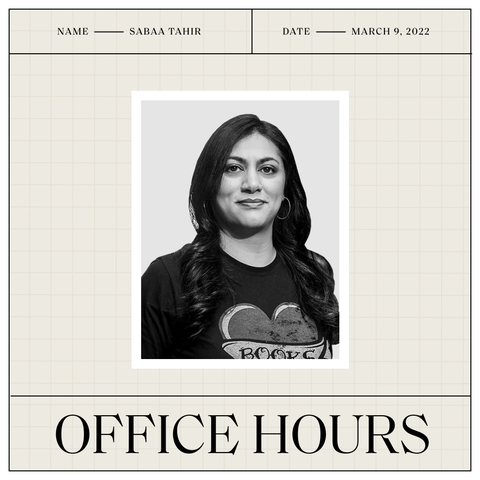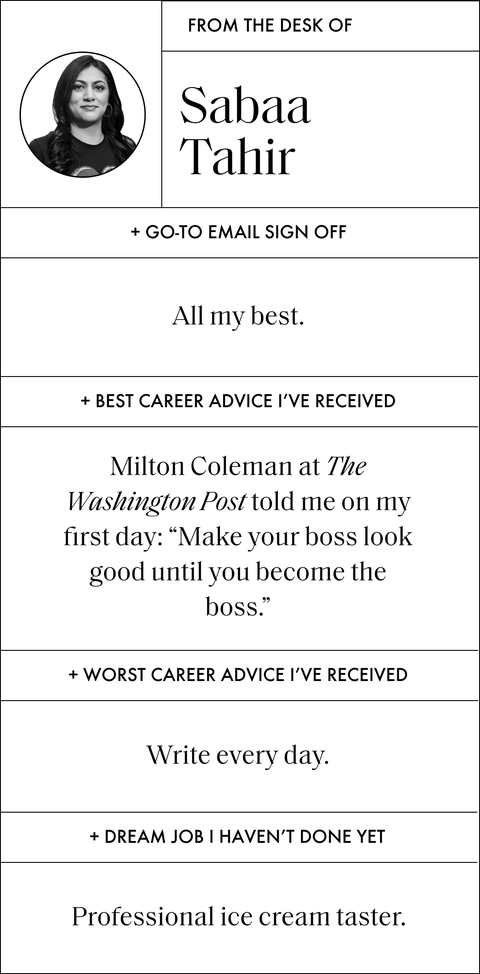
In ELLE.com’s monthly series Office Hours, we ask people in powerful positions to take us through their first jobs,
worst jobs, and everything in between. This month, we spoke with Sabaa Tahir, the author of the bestselling young adult fantasy novel An Ember in the Ashes and its three sequels, making her the first Pakistani-American fantasist to ever hit The New York Times bestseller list for YA. “I couldn’t believe it,” she told ELLE.com about the career-defining moment. “It actually took me a few days to process. I had to set it aside, because it was too big.”Earlier this month, she published her latest novel All My Rage, which follows two outcasts and best friends Sal and Noor as they navigate adolescence and forge their own paths in Juniper, California; the novel will soon be turned into a television series with Tahir co-writing the screenplay. Below, Tahir shares why her new book took 15 years to complete, her best tip for dealing with burnout, and the incredible power of an all-black outfit.
My first job
My parents had a family business—a motel—so my first job was answering the phones. This was way before the internet, so I would give room rates, directions, and tell people whether or not our pool was functioning. I didn’t even consider that this would be applicable later in life, but I think dealing with the public at such a young age taught me how to work hard, troubleshoot, and problem solve, but also how to keep my calm when people were rude or ridiculous. I learned how to not take things people say seriously. That has been very helpful as an author.

What my parents initially thought about my career path
Oh gosh, I was such a disappointment. I was supposed to be a doctor because, to my parents, that was a very secure, respectable career. I did a health care program and worked in a hospital for much of it. I was like, “I don’t like this. This is not what I want to do with my life.” Ultimately my parents were like, “We just want you to be gainfully employed. We want you to be able to take care of yourself, whatever that would be.” They didn’t really understand how you could do that with writing. To be honest, I didn’t understand how you could do that with writing. I ended up pursuing communication and journalism, thinking I would either go into academia or journalism. Then right as I was thinking about applying for Ph.D. programs, I got an internship at TheWashington Post as a copy editor.
How living in my family’s motel inspired me
I didn’t know I was becoming a storyteller by observing the lives of the tenants coming in and out and observing the lives of my parents as they tried to survive that place. There was an exact moment when I realized the motel could be more than just this place filled with ghosts: I was trying to write my college entrance essay during my senior year. You’re supposed to figure out something special about yourself, and I had no idea what to put. But then I started thinking about how I grew up at this motel, and I don’t think anyone else really had that experience. I started thinking, “Well, what did that teach me? How has it changed me?” That’s the first time I realized this was something story-worthy.
The untraditional way I wrote my new novel
It took me 15 years to write All My Rage. It really started as a book about the motel where I grew up and the people who were tenants there, and then it transformed and became a book about the people who ran the motel. Then in 2017, after someone I knew overdosed on fentanyl and passed away, it started becoming a book about trauma and addiction. For a long time, the book was a conversation with myself. I did not think I was going to publish this book. It was this book that I would work on when I was sad or frustrated. I was under contract for An Ember in the Ashes and for three more in that series. That was a lot of pressure. So All My Rage was this creative space where I could work on something that nobody knew about and no one had any expectations for. It was almost like a safe space for me over the course of those 15 years.
How I deal with burnout
I call burnout “the emptying of the creative well.” For a writer, burnout means you don’t have any ideas, and you hate all the ones you do have. You can’t seem to remember how to write a book. That happens to me every few months. I try to acknowledge that it’s not that I’m just tired for a day or bored of the story—it’s that I’m burned out. My creative well is completely empty, and I need to refill it. To do that, I listen to music, watch shows, take walks, read books I’ve loved, and try to discover new ones. Somewhere between watching a show or listening to a new album, I find that writing spirit again. It took me years to learn that. I used to really punish myself and accuse myself of being a lazy or a terrible writer. It took a lot of time and self-love to realize, nope, you’re just burnt out.

Why I love writing young adult fiction
You have to be honest when you write for teenagers. I’m not talking about having to tell a contemporary story; I mean the honesty of humanity. How people treat each other, what their motivations are, and why they want certain things. You also have to let the story take the lead. There’s so much joy in just letting the characters feel the full spectrum of their emotions. For All My Rage specifically, I wanted to be able to show the messy reality of these children’s lives—both in the struggle but also in the beauty and the humor. I love writing for YA because it allows me to focus on hope. It’s something I think people need, especially now.
How I’ve seen YA books evolve in terms of diversity and inclusion
I think there is a greater array of marginalized voices that are being heard, but I think the number is still far too small. I have actually heard some fellow authors who are not marginalized say, “When is this whole diversity thing going to be over?” I remember hearing that and thinking, “Oh, so that’s how it is? You think we’re going to disappear?” The whole point is for us to finally have a seat at the table and be able to tell our stories. So I think it has improved, but there’s much more work to be done.
This interview has been edited and condensed for clarity.

